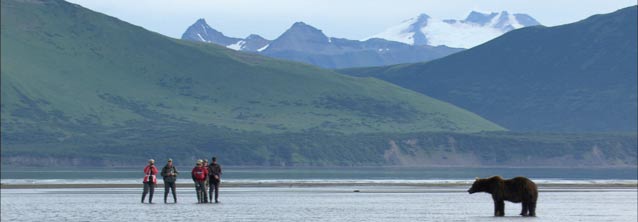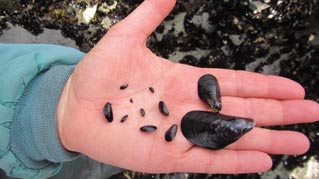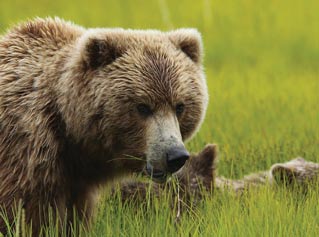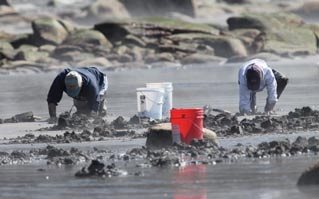
NPS Photo
New Project for 2015
In the spring of 2015, the National Park Service will embark on a new study to investigate the unique link between the terrestrial and nearshore environments, specifically coastal brown bears and intertidal invertebrates.
Clams and other intertidal invertebrates are known to be important early season forage for coastal brown bears along the Alaska Peninsula. This study will expand on this knowledge through a variety of projects. Researchers will map and measure clam and mussel beds along the Katmai and Lake Clark coasts.
Wildlife biologists will collar and observe bears to document movement and use of coastal habitats. Working with park partners, we will evaluate the impacts of changing ocean conditions on intertidal communities. Together, we will gain valuable insight for long-term preservation of this dynamic nearshore connection.
Field work for this exciting new project will begin in 2015 and continue through 2017. Katmai and Lake Clark look forward to keeping the public and our commercial operators informed throughout this project.

NPS Photo
Measuring the Rich Nearshore
Clams and mussels are key components of the nearshore food web, providing food for a multitude of animals including seastars, sea ducks, shorebirds, sea otters, wolves, and bears. Natural and human-related pressures can impact the health of these nearshore invertebrate communities, which in turn can affect those species that rely on them. Although remote, the Katmai and Lake Clark coastlines are still vulnerable to a multitude of changing conditions and disturbances, such as ocean acidification, sea level changes, and oil spills.
This study will map the extent of clam and mussel beds and measure species diversity, composition, and density along the park coasts. Laboratory work will measure the effects of anticipated changes in ocean conditions and potential disturbances to these invertebrates. This information will be useful in emergency response planning and long-term management of ocean and coastal resources.

NPS Photo /Jim Pfeiffenberger
Investigating the Link Between Land and Sea
Coastal brown bears on the Alaska Peninsula are some of the largest in the world, thanks in part to abundant seasonal food resources. Spring is a critical time: after denning through the harsh winter months, yet before the summer and fall salmon runs. For female bears with cubs finding food in the spring is especially important. Abundance of and access to spring forage, including clams, mussels, and sedges, might mean all the difference to survival.
To better understand bear use and movement within coastal habitats and to measure the relative importance of early season forage to long-term health and survival, 12 female bears will be fitted with GPS collars each summer (2015-2017) along the Katmai Coast. Body condition will be evaluated each spring, summer, and fall to compare overall health throughout the season. Blood and hair samples will be collected to measure the relative amounts of marine-derived proteins within the bears’ diets over the entire season. Collaring and recapture of bears for habitat use and health assessments will provide new information on coastal brown bear ecology. Brown and tan collars will be used to reduce their visibility to the public.
The extent to which bears rely on marine-influenced food resources will provide unique insight into the link between the marine and terrestrial ecosystems. This perspective, combined with the intertidal invertebrate work, will help the National Park Service address conservation issues that go beyond park boundaries.

NPS Photo
The Human Dimension
Human communities have been an important component of the Southwest Alaska coastal landscape for thousands of years. Reliance on intertidal resources, especially clams and mussels, is evident in the archeological record. Commercial clamming operations have also contributed to the region’s rich human history.
Today, the collection of clams and mussels remains an important subsistence activity throughout Southwest Alaska. Furthermore, seasonal bear use along the Katmai and Lake Clark coasts attracts thousands of visitors each year for exceptional wildlife viewing. Healthy and enduring intertidal invertebrate communities contribute to these opportunities.
The National Park Service will be actively communicating the activities and findings of this study throughout the life of this project through park websites, research blogs, social media portals and on-site interpretation. We look forward to connecting with you as this unique story unfolds.
Questions
If you have any questions or would like more information on this project, please contact:
Carissa Turner, Coastal Biologist
Katmai National Park, King Salmon, AK (907) 246-2104, carissa_n_turner@nps.gov
Grant Hilderbrand, Regional Wildlife Biologist National Park Service
Anchorage, AK (907) 644-3578, grant_hilderbrand@nps.gov
Part of a series of articles titled Changing Tides Articles.
Last updated: May 1, 2015
